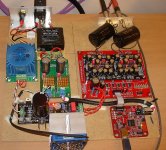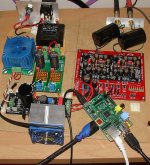Interesting brainstorming !
My custom made project has also an electrostatic screen.
If somebody is interested we can set a group buy.
I would be interested in a group buy
My particle board dac...
I've been listening for several days and it sounds very good. I'm still trying to figure out how to wire the Lundahl 1684 to listen with that for a while. When I setup the transformers I'll rearrange the setup to avoid running the power to the wavio perpendicular to the dac power cable and the i2s ribbon cable...
I've been listening for several days and it sounds very good. I'm still trying to figure out how to wire the Lundahl 1684 to listen with that for a while. When I setup the transformers I'll rearrange the setup to avoid running the power to the wavio perpendicular to the dac power cable and the i2s ribbon cable...
Attachments
I've been listening for several days and it sounds very good. I'm still trying to figure out how to wire the Lundahl 1684 to listen with that for a while. When I setup the transformers I'll rearrange the setup to avoid running the power to the wavio perpendicular to the dac power cable and the i2s ribbon cable...
yes, please tell us all about your experiences and show pictures...
that would be fine... thanks
I've been listening for several days and it sounds very good. I'm still trying to figure out how to wire the Lundahl 1684 to listen with that for a while. When I setup the transformers I'll rearrange the setup to avoid running the power to the wavio perpendicular to the dac power cable and the i2s ribbon cable...
See pdf
5 is + output motherboard
2 is - output motherboard
7 is ground cinchplug
6 is hot cinchplug
On the cinch chassis plug from ground to hot you can place a resistor (rload) of 10k or more depending on the input impedance of the pre-amp.
Attachments
I've been listening for several days and it sounds very good. I'm still trying to figure out how to wire the Lundahl 1684 to listen with that for a while. When I setup the transformers I'll rearrange the setup to avoid running the power to the wavio perpendicular to the dac power cable and the i2s ribbon cable...
only connect the POS and NEG dac output to the primary, regardless if you do serial or parallel. I would the latter by the way...
so NOT connect the COMMON from the DAC to any thing.... just leave it open
the secondary from the transformer goes to hot cinch and GND.
two connections input, two connections output...
How this converter is sound against other commercial products?
If done well DIY is better than ANYTHING commercial on the market

This design is one of those excellent products that a commercial company could never produce..........
Am glad you clarified that with the "done well", I'm just struggling with the done part.......
Also Chanh or Tuyen, can you advise what the differences are if either of you has a heard a KillerDac?
Reinhard, Thanks for the overview, just curious of two things, you mention playing ISO/DSD/ DSF, how do you do this if the DDDACs are PCM? Also, the previous article you mention digital music, burnt well/proper, can this be clarified by software and settings please?
Thanks Fellas,
Drew.
Also Chanh or Tuyen, can you advise what the differences are if either of you has a heard a KillerDac?
Reinhard, Thanks for the overview, just curious of two things, you mention playing ISO/DSD/ DSF, how do you do this if the DDDACs are PCM? Also, the previous article you mention digital music, burnt well/proper, can this be clarified by software and settings please?
Thanks Fellas,
Drew.
has anyone used the DDDAC in through the I2S, bypassing the USB input?
If possible I want to try it direct from either a RPi or BBB.
I believe that you can access the I2S directly from the BBB and I know of at least one application that's looking at controlling audio out of the I2S, just wondering if it's possible to do it with the DDDAC.
Kev
If possible I want to try it direct from either a RPi or BBB.
I believe that you can access the I2S directly from the BBB and I know of at least one application that's looking at controlling audio out of the I2S, just wondering if it's possible to do it with the DDDAC.
Kev
I'm trying that next! It should work ok I hope, will let you know soon... the pi I had was older and didn't have the header where i2s is supplied from. Just got a new one this weekend. There's community work on getting the i2s to work on the beaglebone black (which apparently already has the code for i2s written and tested, search this site for the "buffalo appliance" or for volumio or for rune) and on the udoo board.has anyone used the DDDAC in through the I2S, bypassing the USB input?
If possible I want to try it direct from either a RPi or BBB.
I believe that you can access the I2S directly from the BBB and I know of at least one application that's looking at controlling audio out of the I2S, just wondering if it's possible to do it with the DDDAC.
Kev
I'm trying that next! It should work ok I hope, will let you know soon... .
can't wait 😀
I have used the dac with a raspberry pi through the wave IO. Using the wave IO has the advantage that it isolates the, dirty, computer ground from the dac.
I would be interested in trying it directly, just to be sure of the advantage of the wave IO in between. Or maybe I will be surprised and discover that direct is better?.
You must check the I2S justification; left or right, otherwise you will get no music but noise.
Keep us posted on the progress!
I would be interested in trying it directly, just to be sure of the advantage of the wave IO in between. Or maybe I will be surprised and discover that direct is better?.
You must check the I2S justification; left or right, otherwise you will get no music but noise.
Keep us posted on the progress!
I too had used the pi with the waveio and amanero's, but the pi is notorious for having a bad usb implementation and only with the latest release of volumio (actually, the last relase of raspify before it became volumio) was I able to play 24/192 without noise or skipped bits, with volumio it was not as good as an eepc but it was very listeneable. So I hope the i2s will work ok. But I don't want to be off-topic so I will report if I can get the pi to play with the dac.
Last edited:
I have used the dac with a raspberry pi through the wave IO. Using the wave IO has the advantage that it isolates the, dirty, computer ground from the dac.
I would be interested in trying it directly, just to be sure of the advantage of the wave IO in between. Or maybe I will be surprised and discover that direct is better?.
You must check the I2S justification; left or right, otherwise you will get no music but noise.
Keep us posted on the progress!
I2S is I2S ... if not, it may be Left justified or Right justified... but not left or right I2S ...
So it must be I2S, if that is the case, it will work with the DDAC, I tested that with several I2S sources...
How much power supplies the converter need?
And what are power consumption for single board configuration?
And what are power consumption for single board configuration?
Everything's written on Doede's download page resources.
380mA for the WaveIO, DAC Module 100mA abd Motherboard 10mA.
380mA for the WaveIO, DAC Module 100mA abd Motherboard 10mA.
I2S is I2S ... if not, it may be Left justified or Right justified... but not left or right I2S ...
So it must be I2S, if that is the case, it will work with the DDAC, I tested that with several I2S sources...
Hi Doede,
You are right, it is left justified, right justified or I2S.
It is however not quite true that all I2S connections work.
You might remember that I have tried to connect my philips CD pro loader with I2S output to your dac; that did not work. If I recall correctly it had to do with shifting the bit stream on your motherboard and you advised to use a sample rate converter in between the loader and the dac to solve this problem.
Please correct me if I am wrong.
Good point, you are also correct. the Philips uses 24 bit word length. In the old days, that was considered enough... Due ty 24 bit shifter you MUST have 32 bits word..
MOST sources however will deliver this .....
MOST sources however will deliver this .....
pi with i2s
I got it produce sound, but it doesn't sound too good. There's some artifacts and noise in the playback.
Not knowing enough about how to do it I used Volumio 1.1, turned the i2s driver on and added snd_soc_hifiberry_dac and snd_soc_rpi_dac to /etc/modules (as suggested by a contributor to volumio.org).
I'll read some more in the next few days and see if I can find anything that can help.
I will also hook up an es9023 dac to it and see if that one plays ok. The person who made the suggestion above in volumio.org was using an es9023 dac and did not complain of noisy or distorted sound. If it plays ok it will rule out any bad connection or external noise possibilities. I'll also fix the rpi to the base and straigthen the wires so the they are not crossing/touching each other.
I got it produce sound, but it doesn't sound too good. There's some artifacts and noise in the playback.
Not knowing enough about how to do it I used Volumio 1.1, turned the i2s driver on and added snd_soc_hifiberry_dac and snd_soc_rpi_dac to /etc/modules (as suggested by a contributor to volumio.org).
I'll read some more in the next few days and see if I can find anything that can help.
I will also hook up an es9023 dac to it and see if that one plays ok. The person who made the suggestion above in volumio.org was using an es9023 dac and did not complain of noisy or distorted sound. If it plays ok it will rule out any bad connection or external noise possibilities. I'll also fix the rpi to the base and straigthen the wires so the they are not crossing/touching each other.
Attachments
- Home
- Source & Line
- Digital Line Level
- A NOS 192/24 DAC with the PCM1794 (and WaveIO USB input)

